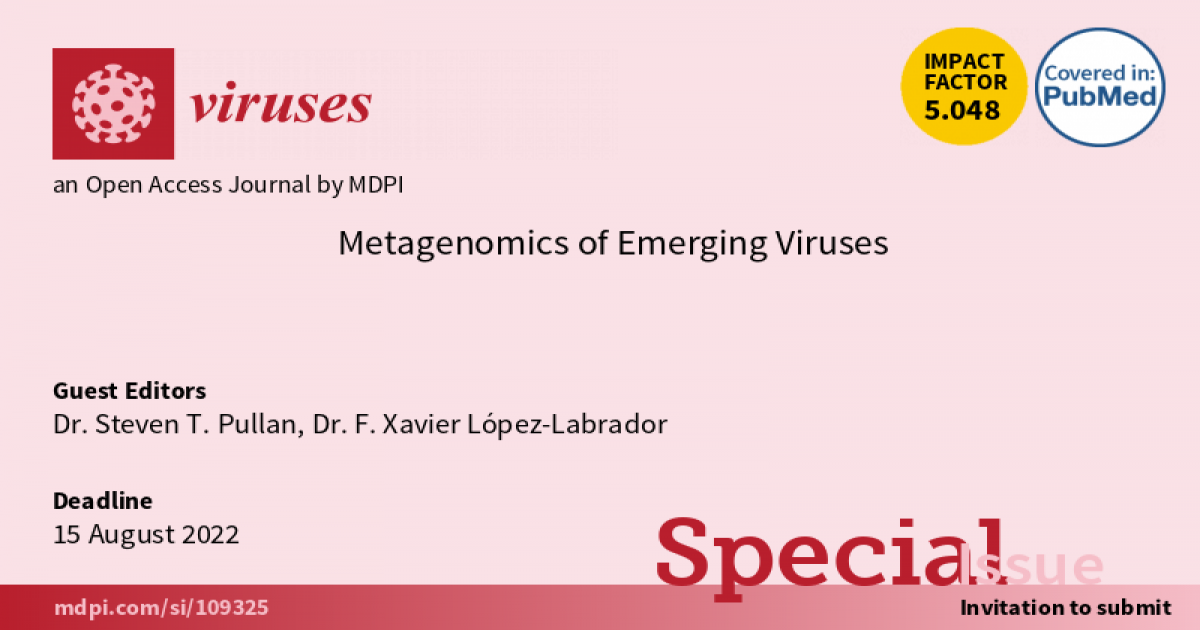- 3.5Impact Factor
- 7.7CiteScore
- 18 daysTime to First Decision
Metagenomics of Emerging Viruses
This special issue belongs to the section “General Virology“.
Special Issue Information
Dear Colleagues,
Genome sequencing has long been established as a key tool in viral discovery and, in more recent years, has become one of the most important components of public health response activity for both local- and pandemic-scale outbreaks. Metagenomic approaches, used appropriately alongside more targeted methodologies, have been of major benefit in the advancement of this area in research, clinical, and public health settings.
This Special Issue invites reviews, opinion articles, or original research papers that explore any methodological developments in, or applications of, metagenomic sequencing methods to the discovery, surveillance, and characterization of emerging viruses and the outbreaks associated with them. Both laboratory and solely bioinformatic analysis-based papers are welcome. Surveillance studies of viruses present in environmental samples and potential animal reservoirs or insect vectors are within scope, as is the characterization of clinical outbreaks. Papers focussing on viral enrichment and host depletion methods to enhance metagenomic viral detection from primary samples will be highly regarded.
Dr. Steven T. Pullan
Dr. F. Xavier López-Labrador
Guest Editors
Manuscript Submission Information
Manuscripts should be submitted online at www.mdpi.com by registering and logging in to this website. Once you are registered, click here to go to the submission form. Manuscripts can be submitted until the deadline. All submissions that pass pre-check are peer-reviewed. Accepted papers will be published continuously in the journal (as soon as accepted) and will be listed together on the special issue website. Research articles, review articles as well as short communications are invited. For planned papers, a title and short abstract (about 250 words) can be sent to the Editorial Office for assessment.
Submitted manuscripts should not have been published previously, nor be under consideration for publication elsewhere (except conference proceedings papers). All manuscripts are thoroughly refereed through a single-blind peer-review process. A guide for authors and other relevant information for submission of manuscripts is available on the Instructions for Authors page. Viruses is an international peer-reviewed open access monthly journal published by MDPI.
Please visit the Instructions for Authors page before submitting a manuscript. The Article Processing Charge (APC) for publication in this open access journal is 2600 CHF (Swiss Francs). Submitted papers should be well formatted and use good English. Authors may use MDPI's English editing service prior to publication or during author revisions.
Keywords
- metagenomic
- emerging viruses
- surveillance
- host depletion
- viral enrichment
- sequencing
- outbreaks

Benefits of Publishing in a Special Issue
- Ease of navigation: Grouping papers by topic helps scholars navigate broad scope journals more efficiently.
- Greater discoverability: Special Issues support the reach and impact of scientific research. Articles in Special Issues are more discoverable and cited more frequently.
- Expansion of research network: Special Issues facilitate connections among authors, fostering scientific collaborations.
- External promotion: Articles in Special Issues are often promoted through the journal's social media, increasing their visibility.
- e-Book format: Special Issues with more than 10 articles can be published as dedicated e-books, ensuring wide and rapid dissemination.

